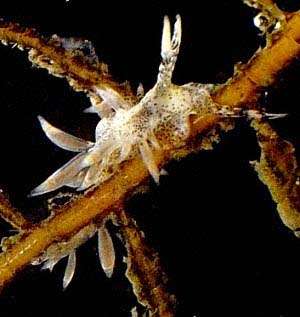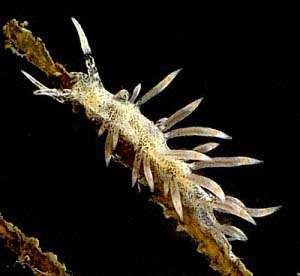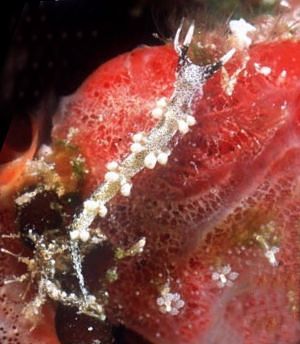

Herviella cloaca
Rudman, 1980
Order: NUDIBRANCHIA
Suborder: AEOLIDINA
Family: Glaucidae
DISTRIBUTION
Known only from East Africa.
PHOTO
On sewer outfall pipe, North Reef, entrance to harbour, Dar es Salaam, Tanzania. May 1974. 8mm long alive. On hydroid Salacia tetracythara. PHOTOS: Bill Rudman.
Herviella, is a genus of about ten or so small species usually with black specks and a gold or orange band below the ceratal tip. The cerata are arranged in a series of sloping single rows down each side of the body.
You may consider the name 'cloaca' rather inappropriate for a beautiful, if tiny, nudibranch. I named it after the place I most often found this species in Tanzania. The main sewer outfall for Dar es Salaam was a large pipe which lay across the muddy raised reef at the entrance to the harbour. Although designed to open in deep water beyond the reef, cracks and leaking joints ensured that much nutritious matter leaked out as the pipe crossed the reef. This made the pipe and its surroundings an extremely rich region for hydroids, and associated invertebrates - and safe enough to visit at low tide if you remembered to wash your hands afterwards. Although the word 'cloaca' is now used as an anatomical term for a combined urinogenital opening, its classical meaning was a 'sewer', the main sewer in Ancient Rome being known as the 'cloaca maximus'. ... and so that is how little Herviella cloaca got its name.
References:
• Baba, K (1960): The genus Herviella and a new species, H. affinis, from Japan (Nudibranchia - Eolidacea). Publications of the Seto Marine Biological Laboratory 8(2, December), 303-305.
• Baba, K (1966): Record of Herviella albida n. sp. from Seto, Kii, Japan (Nudibranchia - Eolidoidea). Publications of the Seto Marine Biological Laboratory 13(5, February), 361-363,Pl.15.
• Baba, K (1966): The anatomy of Herviella yatsui (Baba, 1930) and H. affinis Baba, 1960 (Nudibranchia - Eolidoidea). Publications of the Seto Marine Biological Laboratory 14(April), 1-6,Pls.1-2.
• Burn, R F (1963): Descriptions of Australian Eolidacea Mollusca: Opisthobranchia). 1. The genera Catriona and Herviella. Journal of the Malacological Society of Australia, 7(6 December), pp.12-pp.20.
• Burn, R F (1967): Revision of the genus Herviella (Opisthobranchia: Eolidacea). Malacologia 6(1-2), 223-230.
• Marcus, Er; Burch,JB (1965): Marine euthyneuran Gastropoda from Eniwetok Atoll, western Pacific. Malacologia 3(2), 235-262.
• Rudman, W.B. (1980) Aeolid opisthobranch molluscs (Glaucidae) from the Indian Ocean and the south-west Pacific. Zoological Journal of the Linnean Society, 68(2):139-172.
Rudman, W.B., 1999 (April 9) Herviella cloaca Rudman, 1980. [In] Sea Slug Forum. Australian Museum, Sydney. Available from http://www.seaslugforum.net/find/hervcloa
Related messages
Aeolid from the Seychelles
June 17, 2001
From: Erwin Köhler

Dear Bill,
This one was made by Frank Gloystein (Frank.Gloystein@t-online.de) at the Seychelles, Bird Island on March 14, 2001, length about 1 cm, depth about 18 m.
Erwin
Erwin@medslugs.de
Köhler, E., 2001 (Jun 17) Aeolid from the Seychelles. [Message in] Sea Slug Forum. Australian Museum, Sydney. Available from http://www.seaslugforum.net/find/4563Dear Erwin,
I think this is a species of Herviella and most probably Herviella cloaca. It is a bit diificult to be sure from the photo, but it looks as though there could be a subapical ring on the cerata. One other interesting thing in the photo is the row of three gymnoblastic hydroid polyps on the bottom right. They look quite like the impossibly named Zyzzysus which in Australia lives in association with a sponge and is the food of Cuthona kuiteri which has unique cerata, mimicking the hydroid's polyps.
Best wishes,
Bill Rudman.
